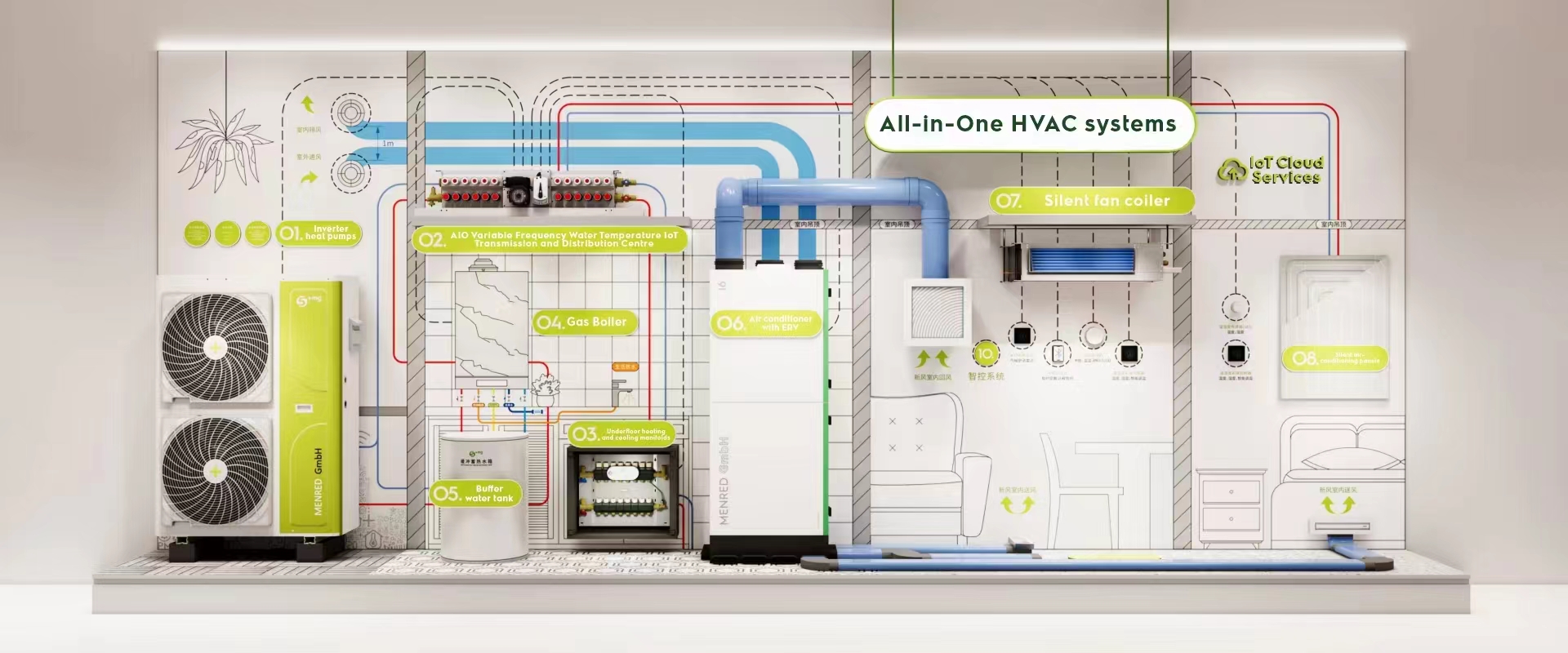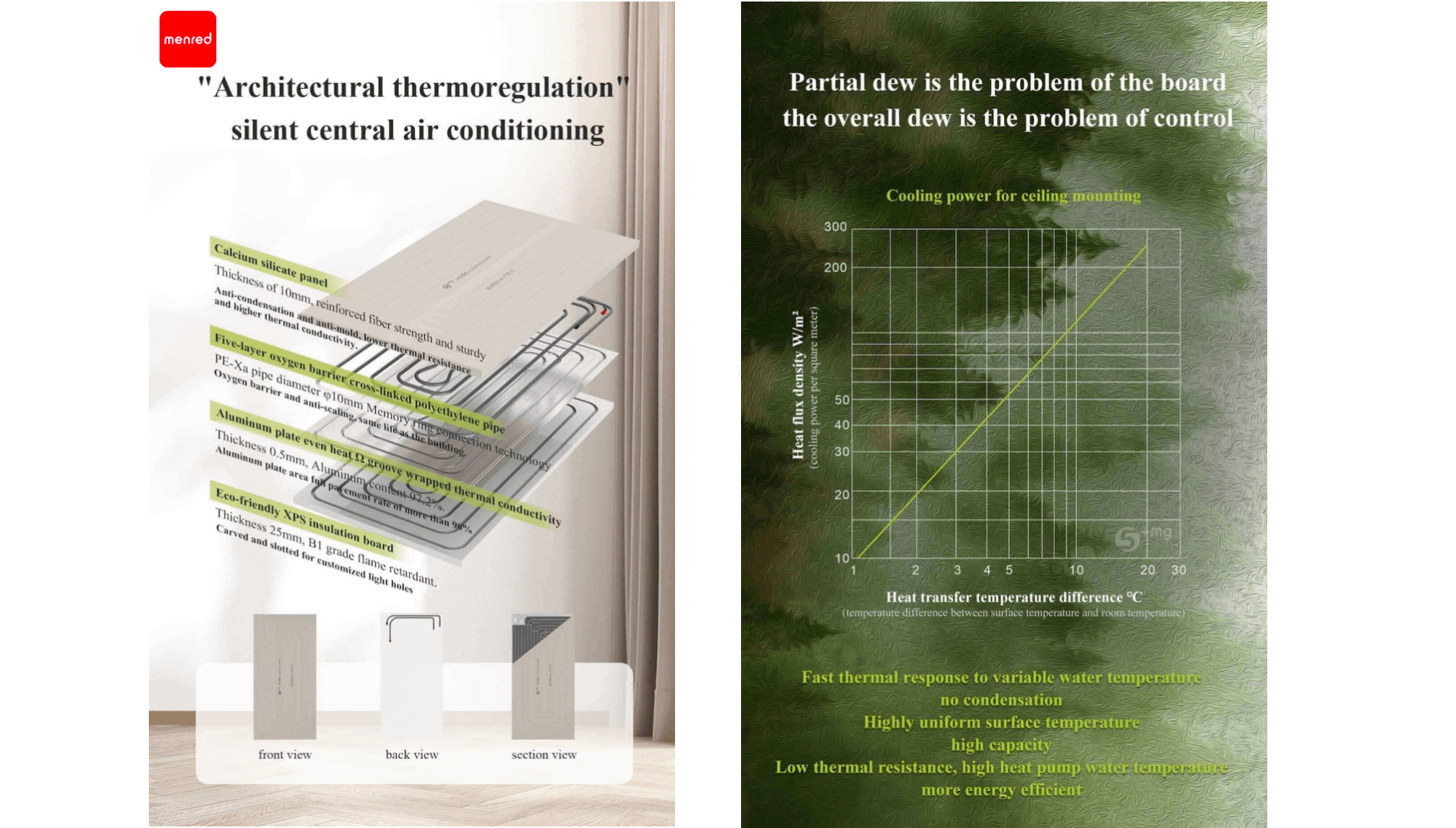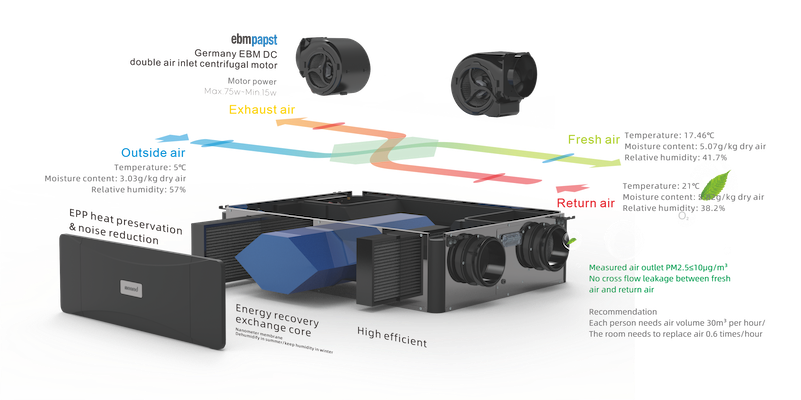How does a radiant cooling system work
views: 4695 time: 2024-11-14
views: 4695 time: 2024-11-14
Radiant cooling is a method of cooling a space by using surfaces (typically floors, ceilings, or walls) that absorb heat from the surrounding environment, rather than relying on forced air or convection. This system cools a room by reducing the temperature of the surfaces that people and objects in the room come into contact with, allowing heat to radiate from the occupants and objects in the room into the cooling surfaces.

1. Cool Water Circulation: Radiant cooling systems often use a network of pipes embedded in the floor, ceiling, or walls. Cool water is circulated through these pipes, typically at temperatures between 13-16°C (55-60°F), depending on the design of the system and the ambient climate.
2. Heat Absorption: As the cool surfaces in the room absorb heat from the air, people, and objects in the room, they effectively lower the overall temperature in the space. The cool surfaces don't make the air cooler directly, but rather they reduce the heat load by absorbing the heat from the environment.
Radiant cooling systems have several distinct features that set them apart from traditional cooling methods like air conditioning or forced-air systems. Here are some key features of radiant cooling:
1. Comfortable and Even Temperature Distribution:
- Radiant cooling systems create a consistent and uniform cooling effect throughout the room. Since the cooling is based on surface temperatures rather than air temperature, there are no hot or cold spots, leading to a more comfortable environment.
2. Energy Efficiency:
- Radiant cooling systems are generally more energy-efficient than conventional cooling systems. They cool the space by absorbing heat from people, objects, and the air, and often require lower water temperatures to maintain comfort, reducing energy consumption.
- These systems can operate effectively at higher room temperatures (e.g., 24-26°C or 75-79°F), lowering energy needs.
3. Silent Operation:
- Unlike traditional air conditioning systems, radiant cooling operates silently because it doesn't rely on fans or blowers. This makes it ideal for spaces where noise is a concern, such as bedrooms, offices, or conference rooms.
4. Reduced Air Movement:
- Traditional air conditioning systems cool by blowing cold air into the room, which can create drafts and stir up dust and allergens. Radiant cooling, on the other hand, doesn't rely on moving air to cool the room, which reduces air circulation and can be more beneficial for people with allergies or sensitivities.
5. Aesthetic Appeal:
- Radiant cooling is typically integrated into the design of the building. Since the cooling elements are embedded in the floors, ceilings, or walls, they are not visible, preserving the aesthetics of the space.
- It eliminates the need for bulky air conditioning units, ducts, or vents, providing a cleaner, more modern look.

6. Zoning and Individual Control:
- Many radiant cooling systems allow for zoning, where different areas of a building can be controlled separately for maximum comfort and energy savings. For example, different rooms or floors can be cooled based on occupancy and usage patterns.
7. Improved Indoor Air Quality:
- Since radiant cooling does not rely on air circulation, there is less dust, pollen, and allergens circulating throughout the space. Additionally, when paired with energy recovery ventilation (ERV) or other air handling systems, it can further improve air quality by ensuring a constant supply of fresh air.
8. Ideal for Dry Climates:
- Radiant cooling works particularly well in dry climates because it avoids the risk of condensation forming on surfaces. It’s less suited for humid environments unless combined with a dehumidification ERV system to prevent excess moisture.
9. Integration with Other Systems:
- Radiant cooling can be integrated with other energy-efficient systems, like heat pumps or solar thermal systems, to enhance its performance and sustainability. This makes it a good choice for green building designs and passive cooling strategies.
10. Low Operating Temperatures:
- The system typically operates with water temperatures in the range of 13–16°C (55–60°F), lower than traditional air conditioning systems, making it less energy-intensive and more sustainable.
11. Suitable for Both Residential and Commercial Spaces:
- Radiant cooling is suitable for a variety of applications, from residential homes to commercial and industrial buildings. It is often used in high-end homes, office buildings, hospitals, and schools where comfort, air quality, and energy efficiency are priorities.
12. Less Maintenance:
- Since there are no fans, compressors, or filters to maintain, radiant cooling systems often require less maintenance than conventional HVAC systems. The main components are usually the piping or panels embedded in the building structure, which typically last for decades without much attention.
Limitations:
- Condensation Risk: In humid environments, there’s a risk of condensation forming on the cooling surfaces, which can lead to water damage or mold growth. To avoid this, dehumidification systems or careful temperature control are necessary.
- Slow Response Time: It is often assumed that radiant cooling doesn’t cool a room as quickly as air conditioning. It works more gradually to reduce the room temperature over time, which may not be ideal in spaces that need fast temperature adjustments.
But this limitation can also be improved,radiant cooling systems can indeed provide a quick cooling effect when operated efficiently. By lowering the water temperature to 7-9°C for a short period, you can achieve a rapid cooling sensation, much like a traditional air conditioning system. After this initial cooling phase, adjusting the water temperature back to the normal 13-16°C range ensures energy-efficient, comfortable, and sustainable operation.This approach takes advantage of the system's ability to absorb heat quickly, especially in spaces with high thermal mass (such as concrete floors or ceilings), which allows the radiant cooling to adjust more rapidly when necessary. It's a smart way to balance both fast cooling and long-term comfort.
Overall, radiant cooling offers a highly energy-efficient, quiet, and comfortable way to cool spaces, especially for people who prioritize indoor comfort, energy savings, and aesthetic design. However, it works best in dry climates or with a dehumidification system in place.
A radiant cooling system requires several key pieces of equipment to function effectively and efficiently. These components work together to circulate cool water, control the system, and ensure optimal comfort. Here are the main pieces of equipment in a radiant cooling system:
1. Radiant Cooling Panels or Pipes:
- Function: These are the primary cooling surfaces in a radiant system. They are embedded in floors, ceilings, or walls and carry cool water to absorb heat from the environment.
- Flooring Systems: Tubing is laid within the floor slab (or in an underfloor heating layer) to absorb heat from the room.
- Ceiling or Wall Panels: These can be mounted on ceilings or walls, often integrated into the building's structure, to absorb heat radiated from the room and occupants.

2. Piping/Manifold System:
- Function: The pipes (often PEX, polyethylene, or copper) are used to circulate chilled water through the radiant cooling panels. A manifold is used to distribute the water from a central location to different areas or zones of the building.
- Components:
- PEX Tubing: Flexible plastic pipes commonly used in radiant systems for their ability to expand and contract with temperature changes.
- Manifolds: A central distribution hub that divides the water flow into various circuits or zones within the system, allowing for even distribution of chilled water.
3. Chilled Water Source:
- Function: A cooling source (often a chiller, heat pump, or cooling tower) provides the chilled water that circulates through the radiant system. The water temperature needs to be maintained between 13–16°C (55–60°F) for effective cooling.
- Options:
- Chillers: These mechanical devices use refrigerants to cool water for circulation in the radiant system.
- Heat Pumps: Air-to-water or water-to-water heat pumps can be used to cool the water in the system.
- Cooling Towers: For larger commercial systems, cooling towers can be used to cool the water that circulates through the system.
4. Control System:
- Function: The control system regulates the temperature of the water circulating through the radiant system. This system helps to maintain desired indoor temperatures and ensures efficient operation.
- Thermostats: Digital or programmable thermostats control the temperature by adjusting the flow of water in the system.
- Zoning Controls: For larger systems, zoning systems allow temperature control in different areas (rooms or floors) to optimize comfort and energy efficiency.
5. Pump:
- Function: A pump circulates the chilled water through the system’s piping and panels. The pump ensures that the water flows through the radiant panels at a consistent rate and pressure.
- Types:
- Circulation Pumps: Low-energy pumps that are designed to circulate water efficiently through the radiant system.
- Variable Speed Pumps: These are used in more sophisticated systems to adjust the water flow according to demand and improve energy efficiency.
6. Insulation:
- Function: Insulation is crucial to prevent heat gain or loss as the chilled water circulates through the pipes, especially if the system is embedded in floors or walls.
- Types:
- Pipe Insulation: To minimize energy loss and prevent condensation on the pipes, which can lead to moisture issues.
- Floor/Wall Insulation: Insulation is often placed under the flooring or around the walls where the radiant panels are located to direct the cooling energy into the space and prevent losses to other areas (e.g., underground or unheated spaces).
7. Dehumidification System (Optional):
- Function: In humid climates, radiant cooling can lead to condensation on the cooled surfaces. A dehumidification system is used to maintain appropriate humidity levels in the space and prevent moisture buildup on surfaces.
- Types:
- Dedicated Dehumidifiers: These systems remove excess moisture from the air and can be integrated with the cooling system.
- Integrated heat pump ERV Systems: sometimes radiant cooling is paired with an heat pump energy recovery ventilation system that handles both cooling and dehumidification.

8. Energy Recovery Ventilator (ERV) / Heat Recovery Ventilator (HRV):
- Function: In buildings that use radiant cooling, it is essential to maintain fresh air without losing energy. An ERV or HRV system helps maintain indoor air quality while conserving energy by transferring heat and moisture between the incoming and outgoing air.
- Benefits: This system can work in tandem with radiant cooling by ensuring a constant supply of fresh air while reducing the cooling load on the radiant system.
9. Water Treatment System (Optional):
- Function: To ensure the longevity and efficiency of the system, the water used in radiant cooling may need to be treated. This can include filtration or chemical treatments to prevent mineral buildup and corrosion in the pipes and components.
- Types:
- Water Filtration: Prevents impurities from circulating in the system, reducing the risk of blockages and buildup.
- Anti-corrosion Treatments: Keeps the pipes and components in good working condition by preventing rust and mineral deposits.
Summary of Key Equipment:
Together, these components create an energy-efficient, quiet, and effective radiant cooling system that can significantly enhance indoor comfort.
and here's how:
1. Heat Gain/Loss Through Leaky Windows:
- Air Leakage: If windows are not airtight, outdoor air can enter the building (during hot weather) or indoor air can escape (in colder weather). This air leakage can undermine the temperature control provided by the radiant cooling system. For example, in summer, warm outdoor air entering through gaps can increase the cooling load, forcing the system to work harder to maintain comfort.
-Energy Loss: Poorly sealed windows can also lead to increased heat transfer, reducing the overall efficiency of the radiant cooling system. Cold air can be lost through gaps, and hot outdoor air can seep in, making the system less effective at maintaining stable temperatures.
2. Reduced Cooling Load Efficiency:
- Radiant cooling systems are designed to absorb heat from the space and transfer it away using cool water. If the room or building is not airtight, additional heat may continuously enter the space through gaps in windows, walls, and doors, effectively increasing the load on the radiant system. This means the system needs to work harder to remove the heat, reducing its efficiency.
- Conversely, in climates where radiant cooling is combined with energy recovery ventilation (ERV), poorly sealed windows can also impact the efficiency of the ERV system, which relies on controlling airflow to maintain indoor air quality and energy savings.
3. Thermal Comfort and Temperature Fluctuations:
- One of the main benefits of radiant cooling is its ability to maintain a stable, even temperature in a space. However, air leaks from windows can cause **temperature fluctuations**. If outside air is allowed to enter freely, it can cause certain areas of the room to become warmer, while others may cool too quickly, creating an uneven comfort level that detracts from the benefits of radiant cooling.
4. Humidity Control:
- In humid climates, air leakage through windows can bring in moisture, which may increase humidity levels and negatively impact the performance of the radiant cooling system. Higher humidity can also lead to **condensation issues**, which radiant cooling systems are more sensitive to. Condensation can form on the cooling surfaces, reducing system effectiveness and potentially causing water damage or mold growth.
5. Interaction with Insulation:
- Airtightness works in tandem with insulation to maintain a controlled indoor environment. While insulation reduces heat transfer through the building envelope, airtightness ensures that the indoor air is contained and stable. In buildings with high airtightness, radiant cooling systems can work more efficiently, as there is less heat infiltration or loss. Properly sealed windows contribute to this by reducing the amount of energy lost or gained through the glazing.
- Seal Gaps and Leaks: Use weather stripping, caulking, or foam sealants around windows, doors, and other openings to prevent drafts and air leakage.
- Energy-Efficient Windows: Consider installing windows with low U-values (good insulation properties) or double or triple glazing to reduce heat transfer. Low-emissivity (low-E) coatings can also help by reflecting heat back into the room or keeping outdoor heat from entering.
- Window Insulation Films: In some cases, applying insulating films to windows can enhance airtightness and improve the thermal performance of the building.
- Proper Ventilation: Ensure that any ventilation systems (like ERVs or HRVs) are correctly sized and balanced to handle the airflow needs of the building without compromising airtightness.

Conclusion:
To maximize the efficiency of a radiant cooling system, ensuring the airtightness of the windows and building envelope is crucial. Proper sealing of windows helps prevent unwanted heat gain or loss, improves the thermal comfort of the space, and allows the radiant cooling system to operate at its full potential.